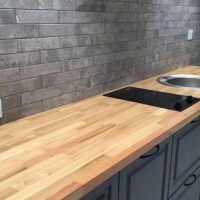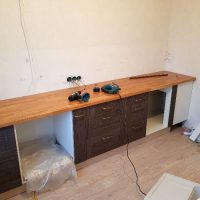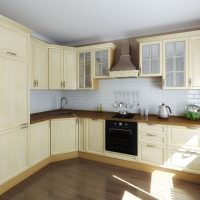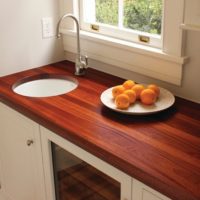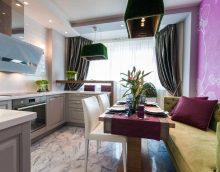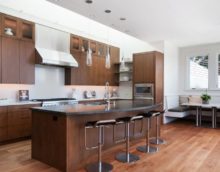Oak countertops for the kitchen - advantages over other types of materials
The countertop is the main subject in the kitchen interior. It is the countertop that is subjected to mechanical and chemical effects, the influence of temperatures. It should not only preserve the appearance after years of operation, but also fit into the design of the kitchen, in harmony with interior details and furniture. An option suitable for all of the above parameters is an oak countertop.

Oak countertops easily fit into any interior design of the kitchen.
Content
Features of oak countertops
Like any material, oak has advantages and disadvantages that affect the choice of the buyer, they are discussed below.
Advantages:
- Wear resistance. Oak countertops are resistant to mechanical confirmations that may occur in the kitchen. A soft, but at the same time strong material softens the blow when heavy objects fall, reducing the likelihood of cracks, chips, and furrows.
- Moisture resistant. Moisture-resistant work surface will remain in its original form, despite spilled liquids on it. It is important to ensure that the initial processing was carried out without technological disruptions.
- Appearance. The wooden surface has a unique natural texture, which, together with the warm sensations in contact, creates an atmosphere of warmth and comfort.
- Variety of colors and processing options. A tabletop made of such material can be selected for absolutely any requirements of the customer and designer, fitting into a variety of interiors.
- Environmental Safety. Natural wood - an environmentally friendly product, covered with high-quality impregnation, eliminates the possibility of harmful fumes in the air and products.

Oak worktops are completely safe material.
Disadvantages:
- High price. Solid oak is not one of the budget elements of the kitchen.
- The need for restoration. For use in the form of kitchen surfaces, oak is coated with impregnation or varnish, which over time loses its appearance and quality. To extend the life of the countertop and restore the look, it is necessary to cover the canvas with new varnish or saturate with oil. Please note that if this recommendation is not followed, moisture resistance decreases and there is a risk of exposure to fungi.
- Low fire resistance. Be careful! Wood is a fire hazardous material, direct exposure to fire will ruin the appearance of the countertop, and may cause a fire.

Over time, the oak countertop will need to be varnished.
The disadvantages of solid oak countertops are rather the special conditions for its operation. Implementation of the care recommendations will ensure its long service life and perfect appearance.
Product Feature
Natural wood is a material ideal for making countertops. Wood is valued for its strength and durability, and oak is superior to other species in terms of quality. The working surface of the kitchen made of this material is maintained in good condition for an average of 30 years. The product does not have a specific appearance, so it does not bother.If necessary, it can be covered with a varnish of a different shade, which will bring novelty to the design of the kitchen.

Oak worktop in modern kitchen design.
Tone selection
The variety of shades of oak makes it possible to choose a countertop that is ideally suited for the interior. The raw material can be of different colors: from light in young trees to dark in perennial oaks. But no matter what the pristine color of the tree is, processing gives it the right tone and emphasizes natural patterns. There are 4 main shades, each of which has many variations:
- Bleached Oak (Scythian). Even the youngest trees do not have white wood - this color is achieved by special technology, it is bleached. Shades range from warm dairy to cold gray. White oak countertops are used in any style of execution of the kitchen - from classic to minimalism and hi-tech.
- Golden Oak (French). The most natural of shades of wood. The purpose of processing in this case is only to emphasize the natural pattern and color depth. The most popular treatments in golden hues are rustic and sedan. Suitable for the interior, made in warm tan.
- Dark Oak (Canadian). The hue of a strong old tree - from cognac to dark chocolate. It is used in luxurious interiors, emphasizing the uniqueness and high cost of the material. A shade is achieved using a special technology - staining.
- Black or oak (stained). The black shade is also natural. This is the most unique and expensive material, but there is the possibility of artificially adding black to the wood. Black oak is suitable for kitchens made in a modern design.
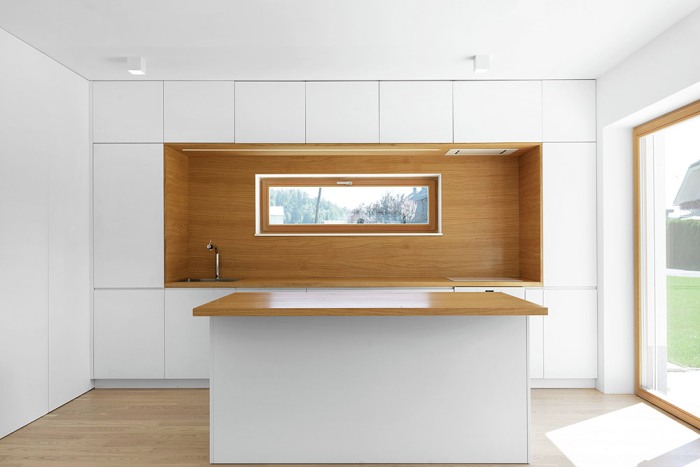
Linear kitchen design with oak countertop.
Any shade can be presented in a matte and glossy finish. Gloss is used if necessary to create a smooth, shiny top. Matte countertops have the effect of raw wood, used to create interiors in the style of country and Provence.
Shape selection
Oak worktops for the kitchen can be made in any form, taking into account the nuances of the design of the room.
- Rectangular
- Square.
- Triangular.
- Oval.
- Round.
- Trapezoidal.

Oak worktops can be glossy or matte.
Wood is a material that can easily be given the desired shape and size, rounded corners or cut figured. Wood can be used not only in the manufacture of a work surface, but also in the creation of a dining table.
The standard thickness of the element is 40 mm, but at the request of the customer, it can be increased to 50-60 mm or reduced to 20 mm, depending on the design project of the kitchen.

Set with oak countertop.
How to choose a countertop
When choosing a wooden tabletop, the client may be faced with a choice: solid wood, glued wood or particleboard, MDF. Visually, these options are similar, but, of course, differ from each other by the characteristics of the material.
Solid wood worktop
The most expensive option is a solid wood array. The polished part of the trunk conveys all the natural patterns and nuances, which makes it unique. Such a countertop is the pride of the owners. There is a nuance - in addition to a higher cost, a solid array is the most demanding in care. If the recommendations are not followed, it may lose its appearance. As a rule, manufacturing is only on an individual order.

Design countertops made of solid wood.
Glued wood countertop
The most popular type of wooden countertops is glued wood. Used in finished products, and can be made to order. Such a canvas consists of elements of the same size - lamellas. This type of countertop is cheaper than solid, more resistant to moisture and less prone to deformation. In general, it can be considered a more practical option than solid oak.

Countertop in the kitchen from glued wood.
Laminated chipboard or MDF
Particleboard and MDF - the most budgetary option that visually resembles a tree, in fact it is different in density chip shavings laminated with plastic. The advantages of wooden countertops do not apply to this type. They are short-lived, the surface can melt under the influence of temperatures, and upon impact, chips and dents form. It is not recommended to order countertops made of this material.

MDF worktop in wood in the kitchen.
Stylish oak worktops
It is difficult to imagine an interior in which a wooden tabletop does not fit. Depending on the color and processing, oak is used both in classical styles and in modern urbanized ones. You can combine a wooden countertop with stone, metal and glass elements and even plastic. Wood adds coziness and warmth even to the most concise kitchen. In the design catalogs, one of the most popular options is the oak coating, more and more customers prefer natural material.

Oak countertop matte finish.
Useful tips and tricks
Solid oak worktops require special attention. With some periodicity, it is necessary to saturate the surface with oil, and overcoat the varnished tabletops. You can verify this by dropping water onto the working area, if it remains on the surface for a long time - no additional coating is required.
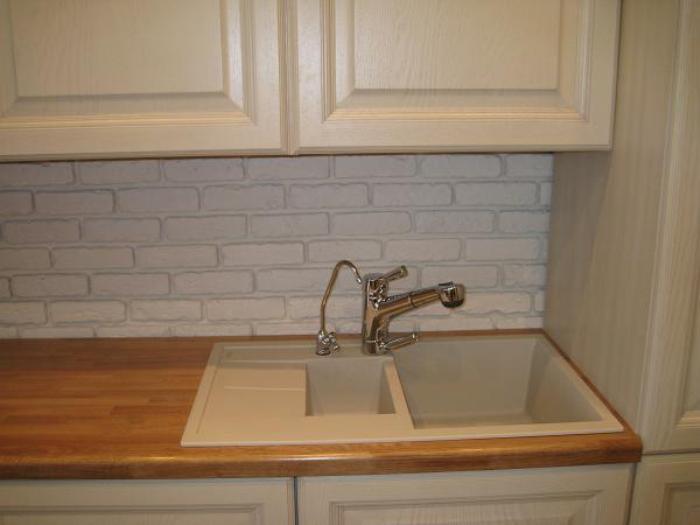
Oak countertops require special care.
Maintaining a state is not difficult. Do not leave spilled liquid on the surface for a long time, to prevent swelling, and also avoid overheating, as the tree may darken. These rules will help to keep the oak countertop in its original form for many years.
Video: Do-it-yourself oak kitchen worktop
50 photo design ideas for oak countertops




